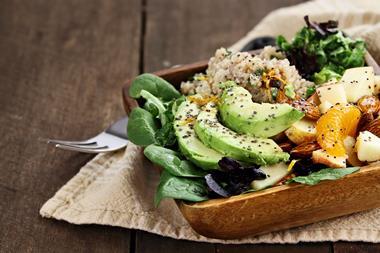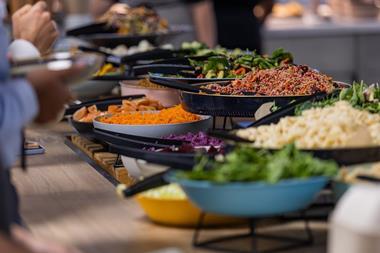Registered nutritionist Dr. Laura Wyness digs into the findings from the FSA’s Food and You survey for MCA’s sister title Food Spark, and explains what they reveal about the UK diet.
Commissioned by the Food Standards Agency (FSA), the Food and You survey is a window into consumers’ food-related activities and attitudes. Conducted every two years since 2010, the questions cover areas such as food choices, affordability of food, food security and safety, and food sustainability.
The findings form the latest interviews (conducted between June and November 2018) have just been released, taking in 2,241 adults aged over 16 across England, Wales and Northern Ireland. Here are some of the most pertinent facts and what they mean for the UK diet:
What we eat
- Only a small proportion of respondents said they were completely vegetarian (3%) or vegan (1%).
- Chicken and turkey were the most frequently eaten types of meat, with 81% of respondents reporting that they ate it at least once a week.
- Around half (55%) of respondents ate beef, lamb or pork once a week. A similar proportion (52%) ate pre-cooked meats such as ham and pate during the same period.
- Over time, the consumption of red meat and pre-cooked meat has gradually fallen. Figures from the 2012 Food and You survey reported 75% of adults ate cuts of beef, lamb or pork at least once a week.
- Almost all respondents (92%) said they consumed milk and dairy foods such as cheese and yoghurt weekly. This was slightly lower than the 97% figure in 2012.
- Three quarters (75%) of respondents ate cooked eggs at least once a week, including 8% who ate them every day.
- 40% ate cooked vegetables (up from 35% in 2012) and 28% ate raw vegetables (up from 20% in 2012) at least once a day.
- One in five (21%) respondents ate pre-packed sandwiches at least once a week, and a quarter (25%) ate ready meals at least once a week.
Analysis: The figures show a decrease in red meat consumption. As red meat is packed with easily absorbed nutrients, it would be interesting to know what foods are being consumed in its place and whether these foods are providing similar nutrients. Dietary data indicates a downward trend over the last nine years of most vitamins and minerals in UK diets. Although the Food and You survey shows an increase in the percentage of people eating raw and cooked vegetables every day (foods that can help provide a variety of vitamins and minerals), the figures are still disappointingly low.
How we shop
- 71% of 16 to 24-year-olds said that they liked to try new things to eat, rising to 83%of 35 to 44-year-olds, before declining among older age groups, bottoming out at 53% of those aged 75 and over.
- Since 2012, the proportions of respondents buying from mini supermarkets has increased from 35% to 43%, while those using supermarket delivery crept up from 10% to 17%.
- Other forms of home delivery (e.g. veg boxes, Hello Fresh and Amazon Fresh) have also increased in popularity (from 2% to 4%).
- A quarter (25%) of respondents aged 16-24 mentioned they had worried about running out of food before there was money to buy more, whereas only 5% of over 75s said the same.
Analysis: It’s encouraging that a high proportion of young adults are keen to try new things to eat. Nutrient intakes of teenagers and young adults are amongst the lowest of any age group and budgeting for food is a concern for this group too. It would be useful to see retailers provide information to encourage shoppers to try different products – for example, healthy, simple, low-cost recipe prompts for shoppers within stores or online. Providing suggestions on how to incorporate a selected foodstuff into a dish, along with a price promotion, could help inspire shoppers to try out new foods and make healthy, affordable meals.
Eating out for breakfast, lunch and dinner
- 11% of respondents said they ate breakfast out or bought a takeaway for breakfast at least once a week, with men twice as likely to indulge in the behaviour as women (14% v 7%).
- 29% ate lunch outside the home over the same period, with men again doing so more often than women (34% v 24%).
- 31% of men and 23% of women said they went out for dinner at least once weekly for an average of 27%.
Analysis: The out-of-home (OOH) environment is currently a focus for public health policy, with recent consultations on mandating calorie labelling and exploring ways to improve this sector. It has been estimated that, on average, up to 25% of our calories may come from eating out, and the OOH sector is projected to grow. This survey shows men are more likely than women to eat a meal outside the home, particularly breakfast. It would be interesting to explore whether there are any differences in food choices between men and women to help inform ways to encourage healthy on-the-go breakfast choices for all.
Trust in the food chain
- More than half (58%) said they were very or quite sure that the food they bought from Britain or UK and Ireland had been prepared to the highest quality standards. This figure was much lower (24%) when considering food from abroad.
- When asked how confident they were that buying or eating food that it was what it said it is on the label or menu, 26% of respondents were confident all of the time (down from 34% in 2016).
Analysis: Having clear labels is important so that consumers can make informed choices about what they are eating. Research indicates that it’s not just nutritional information that consumers are looking for on the label. Shoppers are likely to seek information about how the food has been produced, whether it’s been ethically and sustainably sourced, and if the packaging has no or a low environmental impact. That’s a lot for food companies to consider and get right. The FSA also announced this week that it is introducing a “mechanism to gather data on allergic reactions caused by food served in catering establishments,” while revealing that its consultation on allergen labelling showed majority support (73%) for mandatory full-ingredient labelling – though this was opposed by most businesses, who said it would be challenging to clearly communicate allergens to consumers using this method.
Article originally published on foodspark.com, a digital subscription service designed to inspire and inform innovation across the food industry.
For anyone needing to stay ahead of the culinary curve, Food Spark will offer immediate access to the emerging trends, ingredients, personalities and headwinds defining the future of food. Explore more content by visiting Food Spark or by requesting a demo: joinus@foodspark.com or 01293 610371.
Precis



































